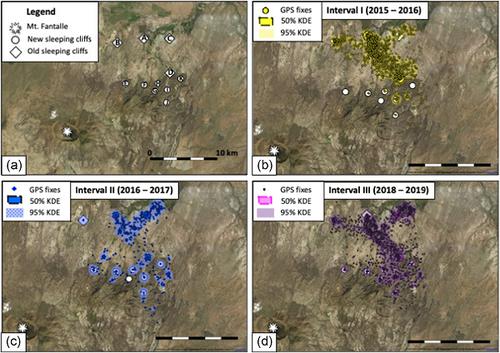当前位置:
X-MOL 学术
›
Am. J. Primatol.
›
论文详情
Our official English website, www.x-mol.net, welcomes your
feedback! (Note: you will need to create a separate account there.)
Home range, sleeping site use, and band fissioning in hamadryas baboons: Improved estimates using GPS collars
American Journal of Primatology ( IF 2.0 ) Pub Date : 2021-03-05 , DOI: 10.1002/ajp.23248 Megan C Henriquez 1, 2, 3 , Alexis Amann 1, 2, 3 , Dawn Zimmerman 4 , Carlos Sanchez 5 , Suzan Murray 4 , Colleen McCann 2, 6 , Teklu Tesfaye 3 , Larissa Swedell 1, 2, 3, 7, 8
American Journal of Primatology ( IF 2.0 ) Pub Date : 2021-03-05 , DOI: 10.1002/ajp.23248 Megan C Henriquez 1, 2, 3 , Alexis Amann 1, 2, 3 , Dawn Zimmerman 4 , Carlos Sanchez 5 , Suzan Murray 4 , Colleen McCann 2, 6 , Teklu Tesfaye 3 , Larissa Swedell 1, 2, 3, 7, 8
Affiliation

|
Variation in spatial and temporal distribution of resources drives animal movement patterns. Links between ecology and behavior are particularly salient for the multilevel society of hamadryas baboons, in which social units cleave and coalesce over time in response to ecological factors. Here, we used data from GPS collars to estimate home range size and assess temporal patterns of sleeping site use in a band of hamadryas baboons in Awash National Park, Ethiopia. We used GPS data derived from 2 to 3 collared baboons over three 8–12‐month collaring intervals to estimate annual and monthly home ranges using kernel density estimators (KDEs) and minimum convex polygons (MCPs). The 95% KDE home range was 64.11 km2 for Collaring Interval I (July 2015–March 2016), 85.52 km2 for Collaring Interval II (October 2016–October 2017), 76.43 km2 for Collaring Interval III (July 2018–May 2019), and 75.25 km2 across all three collaring intervals. MCP home ranges were 103.46 km2 for Collaring Interval I, 97.90 km2 for Collaring Interval II, 105.22 km2 for Collaring Interval III, and 129.33 km2 overall. Ninety‐five percent KDE home range sizes did not differ across months, nor correlate with temperature or precipitation, but monthly MCP home ranges increased with monthly precipitation. Our data also revealed a southward home range shift over time and seven previously unknown sleeping sites, three of which were used more often during the wet season. Band cohesion was highest during dry months and lowest during wet months, with fissioning occurring more frequently at higher temperatures. One pair of collared individuals from Collaring Interval III spent 95% of nights together, suggesting they were members of the same clan. Our results both suggest that previous studies have underestimated the home range size of hamadryas baboons and highlight the benefits of remote data collection.
中文翻译:

狒狒的活动范围、睡眠地点使用和束带裂变:使用 GPS 项圈改进估计
资源时空分布的变化驱动动物的运动模式。对于狒狒的多层次社会来说,生态与行为之间的联系尤其重要,其中社会单位随着时间的推移而分裂和合并,以应对生态因素。在这里,我们使用来自 GPS 项圈的数据来估计埃塞俄比亚阿瓦什国家公园的一群狒狒狒狒的活动范围大小并评估其睡眠地点使用的时间模式。我们使用从 2 到 3 只带项圈的狒狒在三个 8-12 个月的项圈间隔内获得的 GPS 数据,使用核密度估计器 (KDE) 和最小凸多边形 (MCP) 来估计年度和每月的活动范围。 95% KDE 的射程为 64.11 km 2 (2015 年 7 月至 2016 年 3 月)、85.52 km 2 (2016 年 10 月至 2017 年 10 月)、76.43 km 2 (2018 年 7 月至 2019 年 5 月) ),所有三个开孔间隔均为 75.25 km 2 。 MCP 的射程对于领带间隔 I 为 103.46 km 2 ,对于领带间隔 II 为 97.90 km 2 ,对于领带间隔 III 为 105.22 km 2 ,总体为 129.33 km 2 。 95% 的 KDE 活动范围大小在不同月份之间没有差异,也不与温度或降水量相关,但每月 MCP 活动范围随着月降水量的增加而增加。我们的数据还显示,随着时间的推移,活动范围向南移动,以及七个以前未知的睡眠地点,其中三个在雨季使用频率更高。带内聚力在干燥月份最高,在潮湿月份最低,并且在较高温度下更频繁地发生裂变。 项圈区间 III 中的一对项圈个体 95% 的夜晚都在一起度过,这表明他们是同一氏族的成员。我们的结果既表明以前的研究低估了狒狒的活动范围大小,又强调了远程数据收集的好处。
更新日期:2021-04-29
中文翻译:

狒狒的活动范围、睡眠地点使用和束带裂变:使用 GPS 项圈改进估计
资源时空分布的变化驱动动物的运动模式。对于狒狒的多层次社会来说,生态与行为之间的联系尤其重要,其中社会单位随着时间的推移而分裂和合并,以应对生态因素。在这里,我们使用来自 GPS 项圈的数据来估计埃塞俄比亚阿瓦什国家公园的一群狒狒狒狒的活动范围大小并评估其睡眠地点使用的时间模式。我们使用从 2 到 3 只带项圈的狒狒在三个 8-12 个月的项圈间隔内获得的 GPS 数据,使用核密度估计器 (KDE) 和最小凸多边形 (MCP) 来估计年度和每月的活动范围。 95% KDE 的射程为 64.11 km 2 (2015 年 7 月至 2016 年 3 月)、85.52 km 2 (2016 年 10 月至 2017 年 10 月)、76.43 km 2 (2018 年 7 月至 2019 年 5 月) ),所有三个开孔间隔均为 75.25 km 2 。 MCP 的射程对于领带间隔 I 为 103.46 km 2 ,对于领带间隔 II 为 97.90 km 2 ,对于领带间隔 III 为 105.22 km 2 ,总体为 129.33 km 2 。 95% 的 KDE 活动范围大小在不同月份之间没有差异,也不与温度或降水量相关,但每月 MCP 活动范围随着月降水量的增加而增加。我们的数据还显示,随着时间的推移,活动范围向南移动,以及七个以前未知的睡眠地点,其中三个在雨季使用频率更高。带内聚力在干燥月份最高,在潮湿月份最低,并且在较高温度下更频繁地发生裂变。 项圈区间 III 中的一对项圈个体 95% 的夜晚都在一起度过,这表明他们是同一氏族的成员。我们的结果既表明以前的研究低估了狒狒的活动范围大小,又强调了远程数据收集的好处。











































 京公网安备 11010802027423号
京公网安备 11010802027423号